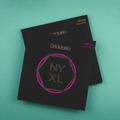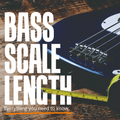Understanding different fret sizes & why they matter
By Strings Direct – 29 August, 2023

In my experience, guitarists don't often talk about different fret sizes. We talk about amps, guitars, pedals, pickups and strings - and yet we often don't look at some of the key elements on our guitars that actually allow us to play. And this includes frets.
I speak partly from personal experience here. I didn't discover that frets came in different sizes until many years into my guitar playing career. And by the time I did realise, I had already bought and used a number of guitars - all of which had frets of different sizes.
As such, in this article I am going to cover frets in more detail. I will look at different fret sizes and the impact that these have on both tone and playability. In this way I hope to provide you with all of the information you need to know about different fret sizes. And in my opinion, this is important for two reasons:
Firstly, you might benefit from changing your frets. As I will explain in more detail throughout, different fret sizes have an impact on playability. So after reading the information here, you might discover that frets of a different size could better suit your playing style.
Additionally, I think it is important to understand some of the main features of guitars. In this way - if and when you go to buy a new instrument - you will be able to make an educated decision about which features are important to you.
So with that in mind, let's get into it! Here is everything you need to know about different fret sizes:
Fret anatomy
Before we look at different fret sizes, I think it is useful to quickly run through the anatomy of a fret.
Firstly, it is important to note that when we talk about fret size, we are talking about the size of the fret wire. We are not talking about the space in between the fret wires (where you place your finger to play notes). That relates to the scale length of your guitar, and is a totally separate topic that I will cover in more detail in future.
For now though, let's return to frets.
Broadly speaking, there are two different sections to a fret. The first of these is embedded in the fretboard. It is called the 'tang' and helps to hold the fret in place.
As you might expect, this section of the fret is of fundamental importance. And yet whilst that is the case, of more relevance here is the section of fret wire that sits above the fretboard. This is called the crown. And all of the following references to fret size here will be focused on this part of the fret.
When discussing fret sizes, there are two elements of the crown that are important to consider. These are the width of the crown, and the height of the crown.
Manufacturers who make fret wire alter both of these elements. So you can get frets that are tall and narrow, or short and wide and so on. Each of these factors has an impact on playability (and to a lesser extent tone) and so I will discuss them in further detail below. First though, let's look at some of the most common fret sizes that you are likely to encounter.

Different fret sizes
Like guitar strings, frets are measured in 1/1000ths of an inch. And also like guitar strings, frets of different sizes are categorised by number. However, just as guitar strings are described as being either light or heavy, frets are also categorised by words that refer to their size.
There are various manufacturers of fret wire. And each manufacturer uses slightly different measurements for different fret sizes. Arguably the most notable manufacturer of fret wire is Dunlop. They make the fret wire that is used on most guitars, and in total they have around 20 different sizes of fret wire.
Of these 20 different fret sizes, they produce 5 sizes of fret wire that are much more common. These are as follows:
6230 - Vintage frets
The smallest fret wire that you are likely to encounter is 6230 fret wire. This was used on early vintage guitars, including pre-1960s Fender guitars. As such, if you have a vintage guitar, then it is likely to be fitted with this type of fret wire. The same is true for many of the modern guitars that are modelled on vintage instruments from the 1950s and '60s.
For this reason, guitar manufacturers typically describe 6230 fret wire as being 'vintage' - even if they are producing it on modern instruments.
6230 fret wire is .078″ wide and .043″ high.
6105 - Modern narrow and tall
Compared with vintage instruments, most modern guitars have frets that are both wider and taller. They are often constructed using 6105 fret wire, which is .090″ wide and .055″ high.
The relationship between the height and width of these frets is actually similar to the vintage frets noted above. The key difference is that these modern frets are larger.
For reasons I will explain in more detail below, these frets are very popular and are used on a wide range of different guitars.
6150 - Vintage jumbo
Although they are less popular than the other fret sizes listed here, vintage jumbo frets are still one of the most common types of frets that you are likely to encounter.
Compared with the fret wire listed above, vintage jumbo frets are much wider. They are made from fret wire that is .102" wide and .042" high. Having said that, they are not quite as tall as either of the previous frets.
In fact, the dimensions of vintage jumbo frets sit almost at the opposite end of the spectrum when compared with modern frets. In other words, rather than being tall and narrow, vintage jumbo frets are short and wide.
6100 - Jumbo
Like vintage jumbo frets, jumbo frets are also wider than the frets on most guitars. However, in contrast to vintage jumbo frets, jumbo frets are also tall. They have a width of .110″ and a height of .055″.
This makes them some of the largest frets available (although you can also get super jumbo frets, which are even bigger). As such, it is not that common for guitars to come with jumbo frets as standard. However it is worth nothing that over the years, a number of notable blues guitarists have opted for jumbo frets. This includes Stevie Ray Vaughan, Rory Gallagher - and more recently players like Philip Sayce and Kenny Wayne Shepherd.
6130 - Medium Jumbo
The last category of fret size worth noting is the medium jumbo.
As the name suggests, medium jumbo frets have dimensions that sit somewhere between modern narrow and tall frets, and jumbo frets. They have a width of .106" and a height of .036″.
In this way they are almost as wide as jumbo frets, but not quite so tall.
For a variety of different reasons that I will explain in more detail below, these frets are also becoming increasingly popular. As such, a lot of modern guitars are fitted with medium jumbo frets.
Fret size & tone
Understanding the type of frets that are popular, and the numbers that manufacturers use to categorise these frets is useful as a first step. But it isn't information that you can really use practically. At this point then, we need to look at the impact that these different fret sizes have on your guitar. And as is often the case, there are two different elements that we need to consider here - tone and playability.
As I will explain in more detail below, I consider the size of frets you use to have a much greater impact on playability than tone. As such, my focus here will predominantly be on this point. This is also because playability is linked to tone. And so if you are playing at your best and can properly express yourself, then you will produce a better tone.
For now though, let's look at tone in as isolated a way as possible.
Proponents of bigger frets argue that they result in 'bigger tone'. And whilst that is an overly simplistic summary, there is some truth in it. In theory, a larger mass of metal should result in 'greater vibrational coupling between string and wood'. And in turn this will produce a stronger and more resonant sound. All things being equal then - bigger frets should have a positive impact on your tone.
The drawback is that bigger frets can also result in a slight loss of clarity. There is a wider break point where the string meets the fret. And this can have an impact on the precision of the notes you play.
However, I am not totally convinced that either of these differences are noticeable within the context of a full rig. When you add an amp, pedals, pickups and different sized strings into the mix, it is unlikely that the size of the frets you use will make a noticeable difference to your tone.
* * * * *
* * * * *
Fret size & playability
As a result, when looking at fret sizes, I think it is much more important to look at the impact that frets have on playability. You are always in contact with your frets - and they are vital in enabling you to create music.
When it comes to playability, there are really two different factors that we need to consider; fret height and fret width.
Let's look first at height:
Fret height
With taller frets, there is less contact between your fingers and the fretboard. This means that you need to apply less pressure for notes to ring out. And in turn this makes techniques like bending and tapping easier.
Having said that, if you have quite a heavy playing style, it is easy to apply too much pressure to the strings with these frets. And this can quite easily push the notes that you are fretting slightly out of tune. The likelihood of this also increases if you favour lighter gauge guitar strings.
Additionally, sliding up and down on a guitar with tall frets can be more challenging. There is more fret material that you need to slide over. You can usually feel the frets under your fingers, and this can make sliding feel clunky and awkward.
Fret width
For this same reason, it can feel easier to slide over wider frets. With wider frets, the angle between the fretboard and the top of the fret crown is less acute. And so you don't feel the fret wire so much under your fingers as you move around your fretboard.
This contributes to a 'smoother' playing feel when using wider frets. And this in turn makes it easier to bend strings. It also helps with sustain.
The drawback of wider frets is that they can create some problems with intonation once they start to get a little worn. This is because the point of contact between the string and fret becomes fractionally closer to the bridge. And this then pulls the note sharp.
Further considerations
The pros and cons of fret height and width are not factors that you should consider independently. They interact with one another and so need to be considered together.
For example, one of the drawbacks of tall frets is that there is an acute angle between the fretboard and the top of the fret. And this means that you can feel the frets under your fingers as you navigate around the fretboard. Yet if you take a tall fret and make it wider, this angle decreases. So you end up with a smoother playing feel, whilst potentially enjoying the benefits of a taller fret.
I say potentially, because in the end the most suitable fret sizes for you will depend on your personal preference. And so the frets that work well in theory might not actually be the best option. This is partly because playability is affected by a number of factors, all of which interact with one another.
For example, if you play using wider frets, you will have less space between each fret to actually play the notes. And the impact of this will be more or less pronounced, depending on the scale length of your guitar.
To talk about scale length in depth is beyond the scope of this article. However it is just to point out that there are many parts of your guitar (other than fret size) which can affect playability. And it is worth taking this into account before you get too focused on fret size.
Putting it all together
Having said that, fret size does have an impact on playability. And so even though there are a number of different and nuanced factors that affect the playability of your guitar, we can outline the characteristics of different fret sizes by looking at their height and width together.
As such, let's return to the 5 common fret sizes listed above, and look at how the height and width of these frets affects their playability:
Vintage frets
As noted above, vintage frets are the smallest frets that you are likely to encounter. Many guitarists are quite disparaging of vintage frets, as they don't see any obvious benefits to them when compared with some of the other fret sizes that are available.
This is largely because of the height of these frets. When you play a guitar with shorter frets, you have to exert more pressure to play each note. This makes it more difficult to bend with these frets. It also makes it more challenging to play fast.

Vintage jumbo frets
Like vintage frets, vintage jumbo frets also tend to be less popular. However in this case, some guitarists take issue with both the height and the width of these frets.
In the 1960s, a lot of Gibson guitars had low and wide frets. And this has led to these guitars being jokingly described as 'fretless wonders'. The width of the frets gives these guitars a very smooth playing feel. You can't really feel the frets under your fingers. And this is great for sliding up and down the fretboard and moving around your guitar.
The significant drawback for blues guitarists, is that as with vintage frets, it is more difficult to bend with these frets. You have to press down harder to fret every note. And this makes bending - as well as playing at speed - more difficult.
Modern narrow & tall frets
Conversely, modern narrow and tall frets are easy to bend and play at speed. The height of these frets means that you don't need to apply very much pressure at all with your fretting hand. In fact, depending on the height of the frets, your fingers might not even touch the fretboard, which can give your guitar an almost scalloped feel.
As noted above, the downside of tall frets is that you can feel them under your fingers as you move around the fretboard. So if you like to include slides in your playing, then you might struggle a little with very tall frets.
Very tall frets can also be problematic if you are a heavy handed player. Applying more pressure than you need can push notes sharp. And so if you like to dig in, very tall and narrow frets might not be appropriate.

Jumbo frets
In fact if you are a very physical guitar player, then you might be better off looking at jumbo frets. Like modern narrow and tall frets, the height of jumbo frets makes string bending and fretting easier. Here though, the added width of the frets helps to offset some of the drawbacks of tall and narrow frets.
It is partly for this reason that over the years, jumbo frets have proven popular with blues guitarists playing with a heavy and physical style.
As noted above, Stevie Ray Vaughan and Rory Gallagher both played using jumbo frets. And modern blues guitarists like Kenny Wayne Shepherd and Philip Sayce - both of whom play a high octane style of blues guitar - play with the same size frets.
Despite these benefits, there is a lot of fret wire under your fingers when you use jumbo frets. And this can feel awkward and uncomfortable for many guitarists. This is particularly the case if you have smaller hands or if you prefer a more streamlined playing feel.
Medium jumbo frets
It is because of these drawbacks that a lot of players prefer to opt for medium jumbo frets. For a lot of guitarists, medium jumbo frets provide a 'best of both worlds' option. They are both wide and tall, without being as big as jumbo frets.
In this way, they facilitate string bending and a more physical style of playing. And yet they do so without being quite so large.
Which fret size is right for you?
At this stage you are probably wondering which fret sizes will work best for you. And with all of the different options and factors to consider, looking at different frets can feel like somewhat of an overwhelming task.
Ultimately, fret size is largely a matter of personal preference. There is not a set or size of frets that will categorically improve the tone and playability of your guitar. There are simply frets that will be more or less suitable for you.
Having said that, for most blues guitarists I think that slightly bigger frets can work well. As I note in more detail here, string bending is an essential part of playing effective blues lead guitar. And so if you are playing blues lead guitar, then it makes sense to optimise your setup to make bending as smooth and easy as possible.
That is not to say you need to go for very tall and wide frets. Rather it is to say that in my opinion, focusing your search on slightly larger frets makes sense. You can then decide whether you want to be more or less adventurous in your choice of fret size.
If you are a physical player and you really like to dig in with your fretting hand, then you might benefit from bigger frets. Conversely, if you have a more mellow playing style - but you want some of the benefits of a larger fret, then a medium jumbo size fret might make a better choice.
Some closing thoughts
Whether you are looking to change the frets on your current guitar, or you just want to pay closer attention to the frets on the next guitar you buy, I would always recommend going to a guitar store in person. Try out similar guitars with different fret sizes, and see what feels best.
Changing your frets is not a hassle free process. So don't take unnecessary risks. Test out a whole range of different fret sizes, whilst trying to keep as many other variables constant (the type of guitar you are using, the gauge of the strings etc). In this way, you will be able to feel the difference that the frets make. And this will help you to decide on the fret sizes best suited for you.

The Happy Bluesman
www.happybluesman.com
@happybluesman







